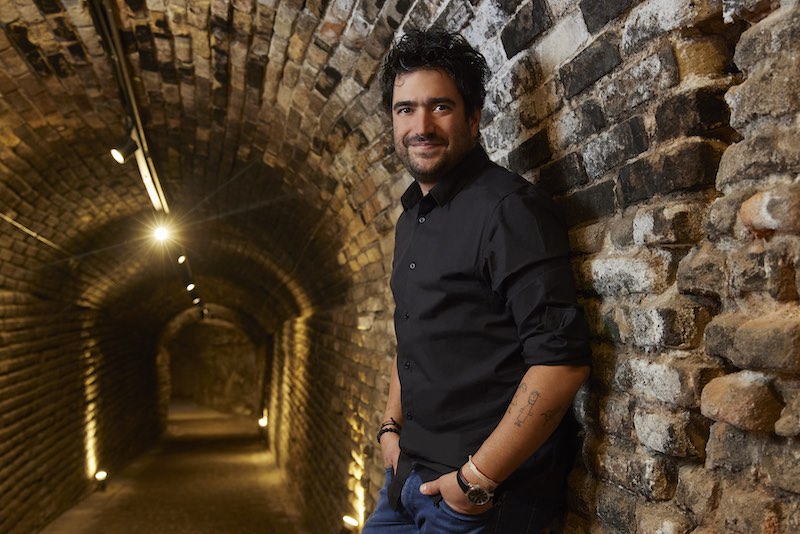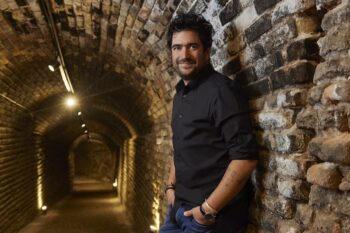

Cuban-born pianist and composer HAROLD LÓPEZ-NUSSA begins an exciting new chapter of his fascinating career with his Blue Note debut Timba a la Americana, a vibrant album teeming with joy and pathos that was inspired by the pianist’s recent decision to leave his Cuban homeland and begin a new life in France. Produced by Snarky Puppy bandleader Michael League, Timba a la Americana unveils a brand-new sound across 10 dynamic original compositions performed by a tight-knit band featuring harmonica virtuoso Grégoire Maret, Luques Curtis on bass, Bárbaro “Machito” Crespo on congas, and Harold’s brother Ruy Adrián López-Nussa on drums.
Harold traces the origins of Timba a la Americana to a day during his family’s first winter after leaving Cuba to live in Toulouse, France. It was cold. He was homesick. Harold found himself flipping through voice memos on his phone, listening to jams and fragments of song ideas he’d documented years before. These happened on gigs, or in the music space of his home, or on the street when he was seized with an idea. The little seedlings of songs ported him back to the rhythmic communication that was part of his everyday life in Cuba.
“It was emotional for me to be in France and listen back to these ideas from the past because the transition for me was not easy,” Harold recalls. “In Cuba, musicians would come to my house several times a week, to play, to party. My daughters grew up going to concerts every week. We were very active with music.”
Those recorded inspirations did more than simply sharpen Harold’s longing for his previous life halfway around the world. They confirmed what he already knew: His next creative moves were going to be different. Very different.
The pianist had released a string of acclaimed Latin jazz projects under his own name and participated in collaborative all-star assemblages like Ninety Miles with Stefon Harris, David Sanchez, and Christian Scott. Still, he felt a strong urge to escape the conventional thinking about song form and structure that’s defined Latin jazz since the 1950s. The ideas on his phone – lyrical melodies, intricate odd-meter vamps – suggested new freedoms, unconventional forms. He wrestled with the challenging shapes of the fragments until they became songs.
“It’s almost like I needed to think about Cuba from far away,” Harold says. “I was having all these feelings of challenge, new life, new things going on for us. It was a lot of new, and of course that would be reflected in the music, but I was still feeling this conflict: I want this music to sound like Cuba, but how can it if I’m not there?”
Those questions, meditations really, on distance and dislocation led Harold to create in ways he hadn’t before. In collaboration with League—a friend of many years who had first heard Harold on a trip to Cuba and later invited the pianist to perform at Snarky Puppy’s GroundUp Music Festival in Miami—the two sought new settings for the clave patterns that are the heartbeat of Cuban music. They grabbed elements of danzon, the foundational dance that began in Matanzas in the late 1800s, and the stately son tumbao riffs that frame the songs of Benny Moré and so many others. They worked with ancient bata drum rhythms used to summon the deities, then incorporated them into the choppy polyrhythmic agitations of modern improvising collectives. They linked the catcalling mambos of Dizzy Gillespie and Machito to modern ideas about song structure.
The result: Timba a la Americana, a provocative, lavishly colorful, effortlessly unified song cycle that amounts to a top-to-bottom modernization of Latin jazz.
Harold knew he was onto something when, prompted by one of the phone fragments, he found himself exploring the wistful mood that became “Mal du Pays.” Rendered with dramatic understatement by Maret, it’s a plaintive theme saturated with the bittersweet longing Brazilians call “saudade.”
“That’s me looking back to Cuba,” Harold says. “I’m thinking about our life there, and my friends and the music we made. When I started it was just a little idea, almost like a baroque theme. As I was playing, I remember thinking that we needed to go into very slow rumba, a specific groove I’ve heard my whole life. It’s a pulse from the neighborhood where I was born in Havana – it’s in the religion, in the celebrations, the ceremonies and the parties. A slow-feeling groove, for older people so they can dance. For me that rhythm stirs something deep and melancholy – it’s rumba but it’s a part of something ancient.”
“Mal du Pays” came together during the first of several collaborative sessions at League’s Barcelona studio. Harold played the tune on acoustic piano; League suggested he open the piece on the Fender-Rhodes electric. “He thought it gave us a more intimate sound,” Harold recalls. “He was right. Then after the rumba is established, it moves to acoustic, and the traditional sound of piano players. This is one of the examples of us trying to do something that has the tradition while at same time mixes with something new.”
That dynamic guides everything on Timba a la Americana from rhythm-forward riffs (“Funky”) to more intricate journeys (“Afro en Toulouse”) to pieces that suggest surreal mashups of the folkloric and the futuristic (“Conga a la Americana”) to the polyrhythmic switchbacks of League’s original “Rat-a-Tat.” Cuba provides the anchoring point of origin; from there Harold and his band volley ideas in a spirit of cosmopolitan modernity that transcends regions and genres and eras.
Timba marks the first time Harold has recorded using electric instruments and synthesizers. It’s a textural change and, also, a sensibility change. He acknowledges that League gently persuaded him to expand his identity as a piano player – not an easy thing given that his credits include performances with Cuba’s National Symphony Orchestra (playing Heitor Villa-Lobos’ Piano Concerto No. 4) and top honors at the Montreux Jazz Festival’s 2005 piano competition.
“Michael really encouraged me to explore that this time. We had this nice Rhodes and then he brought in some other equipment, and we got really into mixing these electronic sounds. That was directly because of Michael. He understood about my need to respect tradition, but he also picked up on my restlessness. He got me out of being comfortable.”
Harold credits League with cultivating a creative fearlessness in the studio. “He wants whatever can expand the possibilities – he just gets ideas flying around. And what amazed me, as we went on, was how he stayed inside the energy we had when we first played together.”
Timba a la Americana doesn’t sound like any of the previous records under Harold’s name. Growing up in a musical family, the pianist graduated from Havana’s Instituto Superior de Artes and toured early on with the singer Omara Portuondo. He made his debut as a leader in 2007 with Canciones. Since then, he’s alternated between small-group projects like the acclaimed Te Lo Dije (2020) and unusual collaborations like the hypnotic Havana-Paris-Dakar (2015) with Senegalese bassist/vocalist Alune Wade. Harold regards Timba as his most expansive and ambitious work and suggests that it might not have happened without the support of Blue Note President Don Was.
“I’d been talking with Don for some time when I was still in Havana,” Harold recalls. “We’d have these discussions just talking about music – records he loves, records I love. Eventually it became about me joining Blue Note. After the contract was done, that was a heavy moment for me. I felt this huge responsibility because of the history of the label. Don totally understood that. He had a lot of confidence in us, which gave us confidence. He wanted us to do what we were feeling, what we wanted to share.”
At its root, the material on Timba a la Americana is derived from a thriving and still-evolving lineage of Afro-Cuban dance music, connecting that magnetic energy to the spontaneous interplay associated with jazz. The blend of elements, the mezcla, is different on each tune – check the shifting cadences and stately piano tumbaos of the opener “Funky,” and the polyrhythmic update of the folkloric conga rhythm from Santiago de Cuba on “Conga a la Americana” – but the idea of live exchange prevails throughout.
“There are some tunes you can think of as having the classic rhythms from long ago, rumba and conga and so on,” Harold says. “Then there are some tunes where the foundational rhythm is not that obvious, and there is some complexity, which I also love. But I didn’t want to lose the groove. I love to dance and I always love it when people are dancing. It says to me that the music is alive.”